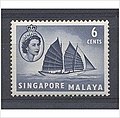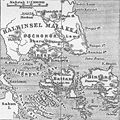Portal:Singapore
 Map of Singapore Singapore, officially the Republic of Singapore, is an island country and city-state in Southeast Asia. The country's territory comprises one main island, 63 satellite islands and islets, and one outlying islet. It is about one degree of latitude (137 kilometres or 85 miles) north of the equator, off the southern tip of the Malay Peninsula, bordering the Strait of Malacca to the west, the Singapore Strait to the south along with the Riau Islands in Indonesia, the South China Sea to the east, and the Straits of Johor along with the State of Johor in Malaysia to the north.
Singapore's history dates back at least eight hundred years, having been a maritime emporium known as Temasek and subsequently a major constituent part of several successive thalassocratic empires. Its contemporary era began in 1819, when Stamford Raffles established Singapore as an entrepôt trading post of the British Empire. In 1867, Singapore came under the direct control of Britain as part of the Straits Settlements. During World War II, Singapore was occupied by Japan in 1942 and returned to British control as a separate Crown colony following Japan's surrender in 1945. Singapore gained self-governance in 1959 and, in 1963, became part of the new federation of Malaysia, alongside Malaya, North Borneo, and Sarawak. Ideological differences led to Singapore's expulsion from the federation two years later; Singapore became an independent sovereign country in 1965. After early years of turbulence and despite lacking natural resources and a hinterland, the nation rapidly developed to become one of the Four Asian Tigers. As a highly developed country, it has one of the highest PPP-adjusted GDP per capita in the world. It is also identified as a tax haven. Singapore is the only country in Asia with a AAA sovereign credit rating from all major rating agencies. It is a major aviation, financial, and maritime shipping hub and has consistently been ranked as one of the most expensive cities to live in for expatriates and foreign workers. Singapore ranks highly in key social indicators: education, healthcare, quality of life, personal safety, infrastructure, and housing, with a home-ownership rate of 88 percent. Singaporeans enjoy one of the longest life expectancies, fastest Internet connection speeds, lowest infant mortality rates, and lowest levels of corruption in the world. It has the third highest population density of any country in the world, although there are numerous green and recreational spaces as a result of urban planning. With a multicultural population and in recognition of the cultural identities of the major ethnic groups within the nation, Singapore has four official languages: English, Malay, Mandarin, and Tamil. English is the common language, with exclusive use in numerous public services. Multi-racialism is enshrined in the constitution and continues to shape national policies in education, housing, and politics. Singapore is a parliamentary republic in the Westminster tradition of unicameral parliamentary government, and its legal system is based on common law. While the country is de jure a multi-party democracy with free elections, the government under the People's Action Party (PAP) wields widespread control and political dominance. The PAP has governed the country continuously since full internal self-government was achieved in 1959, and holds a supermajority in Parliament. One of the five founding members of ASEAN, Singapore is also the headquarters of the Asia-Pacific Economic Cooperation Secretariat, the Pacific Economic Cooperation Council Secretariat, and is the host city of many international conferences and events. Singapore is also a member of the United Nations, the World Trade Organization, the East Asia Summit, the Non-Aligned Movement, and the Commonwealth of Nations. (Full article...)Selected article -Tropical Storm Vamei (also known as Typhoon Vamei) was a Pacific tropical cyclone that formed at about 85 nautical miles (100 mi; 160 km) from the equator—closer than any other tropical cyclone on record. The last storm of the 2001 Pacific typhoon season, Vamei developed on 26 December at 1.4° N in the South China Sea. It strengthened quickly and made landfall along extreme southeastern Peninsular Malaysia. Vamei rapidly weakened into a remnant low over Sumatra on 28 December, and the remnants eventually re-organized in the North Indian Ocean. Afterward, the storm encountered strong wind shear once again, and dissipated on 1 January 2002. Though Vamei was officially designated as a tropical storm, its intensity is disputed; some agencies classify it as a typhoon, based on sustained winds of 120 km/h (75 mph) and the appearance of an eye. The storm brought flooding and landslides to eastern Peninsular Malaysia, causing $3.58 million in damage (2001 USD, $6.16 million 2025 USD) and five deaths. (Full article...) Selected picturePhotograph credit: Chensiyuan The Singapore National Day Parade is a national ceremony in Singapore that takes place each year on 9 August to commemorate the country's independence. The firework display seen here was part of the festivities in 2011, held at The Float @ Marina Bay, the world's largest floating stage and football stadium, located on the waters of the Marina Reservoir. In the foreground on the right is the lotus-flower-shaped ArtScience Museum, situated within Marina Bay Sands, an integrated resort that opened in the same year.
General imagesThe following are images from various Singapore-related articles on Wikipedia.
Selected biography -Edwin Nadason Thumboo B.B.M. and Bar, PJG (born 22 November 1933) is a Singaporean poet and academic who is regarded as one of the pioneers of English literature in Singapore. Thumboo graduated in English from the University of Malaya in 1956. Although he applied for a position at the university, he was rejected as few locals held academic posts at that time. He therefore worked in the civil service for about nine years before finally joining the university, then renamed the University of Singapore, in 1966 following Singapore's independence. He received a Ph.D. from the university in 1970. Thumboo rose to the position of full professor in the Department of English Language and Literature, heading the department between 1977 and 1993. After the merger of the University of Singapore and Nanyang University in 1980 to form the National University of Singapore (NUS), he was the Dean of the Faculty of Arts and Social Sciences from 1980 to 1991, NUS's longest-serving dean of the Faculty of Arts and Social Sciences. Thumboo was the first Chairman and Director of the university's Centre for the Arts from 1993 to 2005, and continues to be associated with the university as an emeritus professor, a position he has held since retiring from full-time teaching in September 1997. (Full article...) Did you know (auto-generated)
In this month
More did you know -
Selected panoramaThe National Stadium (Chinese: 国家体育场; Malay: Stadium Nasional Singapura) is located in Kallang. Opened in July 1973, the National Stadium was officially closed on June 30, 2007 and will be demolished in late 2008 to make way for the Singapore Sports Hub which is expected to open in 2011. Singapore topicsRelated portalsSoutheast Asia Other Countries Tasks
CategoriesWikiprojectsAssociated WikimediaThe following Wikimedia Foundation sister projects provide more on this subject:
Discover Wikipedia using portals |
































































